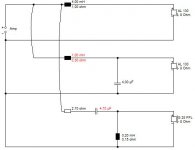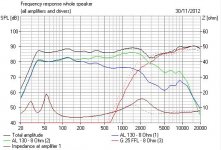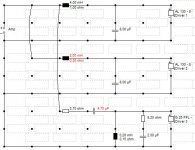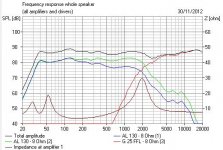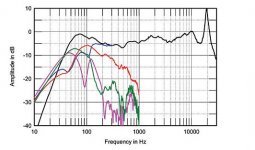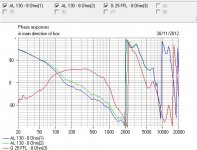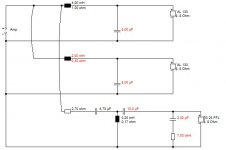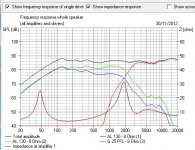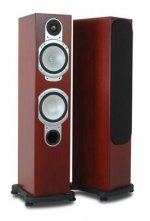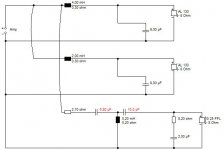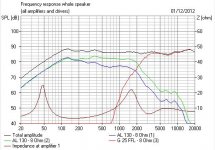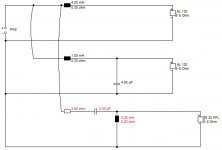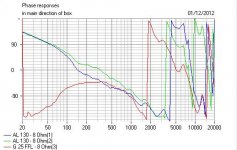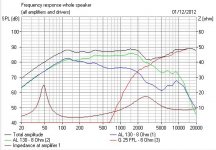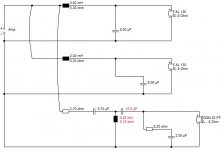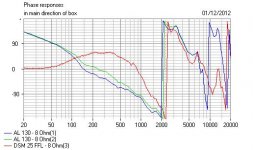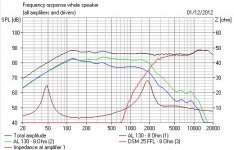😱
Ok, i discover the Xover is direct mounted on the rear terminal...
😎
What i notice too, with a direct listen on the speakers, is that the "problem" seems to came from the mid driver,when vocals came in action. No harsh from the tweeter. The mid band seems confused and harsh at the top end.
I believe if i tamed the mid drive a little at the top, i can manage the situation. I'll start to increase 1uF (Intertechnik MKP) // Mid Drive, and listen.
Bye
😀
Ok, i discover the Xover is direct mounted on the rear terminal...
An externally hosted image should be here but it was not working when we last tested it.
😎
What i notice too, with a direct listen on the speakers, is that the "problem" seems to came from the mid driver,when vocals came in action. No harsh from the tweeter. The mid band seems confused and harsh at the top end.
I believe if i tamed the mid drive a little at the top, i can manage the situation. I'll start to increase 1uF (Intertechnik MKP) // Mid Drive, and listen.
Bye
😀
😀
Good evening.
A week ago i solve the S6 invasion in the back, by the wire terminal. The Xover is attached to the block.
I change this 4uF polyester type cap, at mid band filter...
...by this new MKP-QS, 4,7uF 400V, from Audyn.
It upgrade the top midband clarity and confort at listening. Much less fatigue and the snare drum in Herbie Hanckock's "Future Schock" sounds now more "correct".The same happens with the high pitch vocals.
A simple and very decent upgrade.
Thanks to all your help, Good People.
Bye
🙂
Good evening.
A week ago i solve the S6 invasion in the back, by the wire terminal. The Xover is attached to the block.
I change this 4uF polyester type cap, at mid band filter...
An externally hosted image should be here but it was not working when we last tested it.
...by this new MKP-QS, 4,7uF 400V, from Audyn.
An externally hosted image should be here but it was not working when we last tested it.
It upgrade the top midband clarity and confort at listening. Much less fatigue and the snare drum in Herbie Hanckock's "Future Schock" sounds now more "correct".The same happens with the high pitch vocals.
A simple and very decent upgrade.
Thanks to all your help, Good People.
Bye
🙂
Hello my friend I too have the same speakers and I also want to improve the crossover has changed and nothing else; any resistance;
😀
After make some auditions with new gear in the retailers, i feel the trend is to droping the treble a bit. I advise you to check the 22Ohms parallel with the tweeter, solution, as Rob did. I believe its better if you do it at the crossover board, since i couldn't retrieve de tweeter driver from the cabinet; and i don't want to use too much force and damage the enclosure.
😉
After make some auditions with new gear in the retailers, i feel the trend is to droping the treble a bit. I advise you to check the 22Ohms parallel with the tweeter, solution, as Rob did. I believe its better if you do it at the crossover board, since i couldn't retrieve de tweeter driver from the cabinet; and i don't want to use too much force and damage the enclosure.
😉
Just ran a quick sim of this speaker. Phase is TERRIBLE! Tweeter crossover has an unnaturally small capacitor, doubtless to protect it from overdriving. It should be 8uF really to optimise everything. 😀
My finding was that the second woofer should have a 2mH coil, not 1mH.
Add shunt capacitors to taste. 2X 4uF is OK, 2X 8uF better. Cuts out a lot of metal cone breakup rubbish. Zobel to tame the rising tweeter response.
My finding was that the second woofer should have a 2mH coil, not 1mH.
Add shunt capacitors to taste. 2X 4uF is OK, 2X 8uF better. Cuts out a lot of metal cone breakup rubbish. Zobel to tame the rising tweeter response.
Attachments
Last edited:
😛
Holly Sh*t, with this upgrade or others, it began to sound like a gold series speakers.
Actually i'm tempted to try the tweeter mod. I've got 4 MKP 1uF 5% caps from Inter Tecnik at stock and all i have to get are the 8,2 Ohms resistors.
May be i use the original MA 4uF MKS caps in the low drive, to clean up a bit the top.
Not a so dramatic change, but a step foward.
Do you agree with this option, System 7?
Thank You very much for the schematics an simulation you did.
You're running the hard gear.
😀
Holly Sh*t, with this upgrade or others, it began to sound like a gold series speakers.
Actually i'm tempted to try the tweeter mod. I've got 4 MKP 1uF 5% caps from Inter Tecnik at stock and all i have to get are the 8,2 Ohms resistors.
May be i use the original MA 4uF MKS caps in the low drive, to clean up a bit the top.
Not a so dramatic change, but a step foward.
Do you agree with this option, System 7?
Thank You very much for the schematics an simulation you did.
You're running the hard gear.
😀
It's one of those little irritations to the competent designer that when it's all finished and near perfect, the bean-counters move in and start stripping out expensive components and generally muck up a nice product in favour of a quick buck! 😀
8uF and 10uf 250V polypropylenes are the first to go. Followed by Zobels. Naturally the resulting brash and lively result tends to pall with further listening. As here. 🙄
Here's what I think the original designer did, before it got pared down. You see the midrange is less peaky at 1.5kHz and harsh cone breakup is reduced at 5-10kHz, there isn't a dip at 3kHz because we are using 3rd order treble filter, and the top end is less peaky because of the Zobel which IMO is essential with metal domes. It's actually rather good, though I haven't modelled the bass exactly here.
Start with the stereophile measured response of the released speaker. Does it all makes sense now? 😎
Oh, and in answer to your question, as long as the bass shunt capacitors are roughly similar, the two woofers stay aligned on phase. But bigger than 4uF helps cone breakup suppression.
8uF and 10uf 250V polypropylenes are the first to go. Followed by Zobels. Naturally the resulting brash and lively result tends to pall with further listening. As here. 🙄
Here's what I think the original designer did, before it got pared down. You see the midrange is less peaky at 1.5kHz and harsh cone breakup is reduced at 5-10kHz, there isn't a dip at 3kHz because we are using 3rd order treble filter, and the top end is less peaky because of the Zobel which IMO is essential with metal domes. It's actually rather good, though I haven't modelled the bass exactly here.
Start with the stereophile measured response of the released speaker. Does it all makes sense now? 😎
Oh, and in answer to your question, as long as the bass shunt capacitors are roughly similar, the two woofers stay aligned on phase. But bigger than 4uF helps cone breakup suppression.
Attachments
Last edited:
😉
Hi Steve. At the second option you sacrifice bass extension and correct the gap between the mid and treble drivers.
I try the first tweeter setup, and i'm running the gear now. It sounds to me that the mid band is a little proeminent, create a bit nasalization effect. Treble sounds fine at cymbals, but the link point with the mid band seems worst. Running some hours to burn the addition and new welding.
Most probably it returns to the former situation or get all the parts and run a full update.
The gang:
The gang running the show:
Thanks once more, Steve.

Hi Steve. At the second option you sacrifice bass extension and correct the gap between the mid and treble drivers.
I try the first tweeter setup, and i'm running the gear now. It sounds to me that the mid band is a little proeminent, create a bit nasalization effect. Treble sounds fine at cymbals, but the link point with the mid band seems worst. Running some hours to burn the addition and new welding.
Most probably it returns to the former situation or get all the parts and run a full update.
The gang:
An externally hosted image should be here but it was not working when we last tested it.
The gang running the show:
An externally hosted image should be here but it was not working when we last tested it.
Thanks once more, Steve.

Last edited:
The tweeter Zobel should really only tame the treble around 5-10kHz by a couple of dB without affecting the crossover point performance. You could reduce its effects with, say, 8.2R (7-10W W/W preferably) and a mere 1uF. That is a typical value for a 0.05mH Le, 6R DC tweeter.
It's a bit all or nothing with the rest of it. I really couldn't find another solution that leaves a good impedance and power handling. I did sim a filter (below) that reuses the 0.2mH coil, but the impedance dip to 6 ohms @ 3kHz leaves me slightly uncomfortable.
Truthfully, the second order tweeter filter that MA use is a bit rubbish here. The whole modification should make for a much more refined sound IMO. Reducing the metal cone breakup should help a lot, and I think it will image better.
Ignore the bass response, that is just a trick I use to get the Boxsim optimiser to do what I want. It isn't affected here. LOL
It's a bit all or nothing with the rest of it. I really couldn't find another solution that leaves a good impedance and power handling. I did sim a filter (below) that reuses the 0.2mH coil, but the impedance dip to 6 ohms @ 3kHz leaves me slightly uncomfortable.
Truthfully, the second order tweeter filter that MA use is a bit rubbish here. The whole modification should make for a much more refined sound IMO. Reducing the metal cone breakup should help a lot, and I think it will image better.
Ignore the bass response, that is just a trick I use to get the Boxsim optimiser to do what I want. It isn't affected here. LOL
Attachments
Last edited:
Steve,
How will the speaker sound if replacing 2.7 Ohm by 3.9 Ohm resistor, 4.7 uF by 3.3 uF capacitor, 0.2 mH by 0.25 mH inductor for the tweeter?
How will the speaker sound if replacing 2.7 Ohm by 3.9 Ohm resistor, 4.7 uF by 3.3 uF capacitor, 0.2 mH by 0.25 mH inductor for the tweeter?
That's going in the wrong direction really. You've got a low crossover on the metal drivers as is normal practice, but a high crossover on the tweeter. It just makes a huge hole in the midrange...Steve,
How will the speaker sound if replacing 2.7 Ohm by 3.9 Ohm resistor, 4.7 uF by 3.3 uF capacitor, 0.2 mH by 0.25 mH inductor for the tweeter?
Notice how bad phase is on this speaker.
Attachments
🙂
Hi everybody.
Actually i found two 8,2 ohms, 5W resistors in my stock. If Steve confirm that this Zobel network dont affect cross over point between tweeter and mid drive, so, let it be as it is (8.2Ohms + 2uF).
Kind regards
😛
Hi everybody.
Actually i found two 8,2 ohms, 5W resistors in my stock. If Steve confirm that this Zobel network dont affect cross over point between tweeter and mid drive, so, let it be as it is (8.2Ohms + 2uF).
Kind regards
😛
I will show you the modelling of the standard MA speaker without and with the Zobel. As you can see, it just rolls off the top end as predicted. Sounds far better to my ears with metal tweeters which have some issues at the top:
E0047-04 T29MF001
I can always hear a metal tweeter dome. They make classical piano sound metallic. But nice on rock and jazz drums. 🙂
Metal woofers have all sorts of breakup modes around 5-10kHz. The SEAS Thor crossover attempts to notch what is a tidy 4.8kHz single peak here. Most metal cones are worse than this.
If you look at the W18E001 driver frequency response, you can see why it has this:
E0018-08S W18E001
The whole thing is discussed at Klippel, if you are interested:
Vibration analysis
Klippel modelling gets quite close to the more typical SEAS L18RNX/P driver. Bit of a pig to tame that one!
E0047-04 T29MF001
An externally hosted image should be here but it was not working when we last tested it.
An externally hosted image should be here but it was not working when we last tested it.
I can always hear a metal tweeter dome. They make classical piano sound metallic. But nice on rock and jazz drums. 🙂
Metal woofers have all sorts of breakup modes around 5-10kHz. The SEAS Thor crossover attempts to notch what is a tidy 4.8kHz single peak here. Most metal cones are worse than this.
An externally hosted image should be here but it was not working when we last tested it.
If you look at the W18E001 driver frequency response, you can see why it has this:
E0018-08S W18E001
The whole thing is discussed at Klippel, if you are interested:
Vibration analysis
Klippel modelling gets quite close to the more typical SEAS L18RNX/P driver. Bit of a pig to tame that one!
Last edited:
😕
Sorry Steve, but i'm a bit lost with the meaning of the 1st and 2nd graphic.
The idea was to prevent the depression after 10Khz and the peak at 20Khz with the 8,2 Ohms+2uF, even with the original crossover of the MA Silver S6; to tame the top a bit.
Wasn't it?
By the way, which software do you use for loudspeaker simulation?
😉
Sorry Steve, but i'm a bit lost with the meaning of the 1st and 2nd graphic.
The idea was to prevent the depression after 10Khz and the peak at 20Khz with the 8,2 Ohms+2uF, even with the original crossover of the MA Silver S6; to tame the top a bit.
Wasn't it?
By the way, which software do you use for loudspeaker simulation?
😉
I'm using Visaton Boxsim. Very nice, very easy!
Downloads
Also substituting the Visaton AL-130 driver which is a typical metal cone:
AL 130 - 8 Ohm
And the soft dome G25FFL. I gotta admit I thought that was a metal dome, but it shouldn't matter much, but I might remodel it with something else...😱
G 25 FFL - 8 Ohm
A Zobel just reduces treble by 2dB in conjunction with an attenuating resistor on the input to the filter. That's what the diagram shows. Doesn't sound like much, but these sort of differences make a level mismatch stand out. It won't cure the characteristic aluminium tweeter peak at around 27kHz, but will reduce it.
Downloads
Also substituting the Visaton AL-130 driver which is a typical metal cone:
AL 130 - 8 Ohm
And the soft dome G25FFL. I gotta admit I thought that was a metal dome, but it shouldn't matter much, but I might remodel it with something else...😱
G 25 FFL - 8 Ohm
A Zobel just reduces treble by 2dB in conjunction with an attenuating resistor on the input to the filter. That's what the diagram shows. Doesn't sound like much, but these sort of differences make a level mismatch stand out. It won't cure the characteristic aluminium tweeter peak at around 27kHz, but will reduce it.
Last edited:
🙄
Ok, Steve. So, the high pass notch (8,2Ohms+2uF) only attenuates the tweeter response by 2db or more, after "what" zone?
It will cut a bit the 20Khz peak, but don't correct the 10khz + depression, only deeps it a bit.
After all we dont have MA Silver S6 tweeter model and specs.
Best regards
😀
Ok, Steve. So, the high pass notch (8,2Ohms+2uF) only attenuates the tweeter response by 2db or more, after "what" zone?
It will cut a bit the 20Khz peak, but don't correct the 10khz + depression, only deeps it a bit.
After all we dont have MA Silver S6 tweeter model and specs.
Best regards
😀
Don't worry, it's not hard to modify an existing design if you have certain goals in mind. It's enough to know the general principles of filters. 😀
I remodelled it with a metal dome tweeter, and it's not much different. BUT PHASE is now a DELIGHT. This confirms a new principle for me. Use paper tweeters with paper woofers, and metal tweeters with metal woofers for good phase. 😎
Here's the final design. You can use the existing treble filter for now, but I'd recommend the third order. 10uF is OK, but 15uF is now optimum. Beyond a certain point, you have to live with that top treble rise. It's not easy to notch tweeters without taking impedance too low.
I remodelled it with a metal dome tweeter, and it's not much different. BUT PHASE is now a DELIGHT. This confirms a new principle for me. Use paper tweeters with paper woofers, and metal tweeters with metal woofers for good phase. 😎
Here's the final design. You can use the existing treble filter for now, but I'd recommend the third order. 10uF is OK, but 15uF is now optimum. Beyond a certain point, you have to live with that top treble rise. It's not easy to notch tweeters without taking impedance too low.
Attachments

Thanks Steve.
If the MA Silver S6 tweeter is similar to the RS6, the depression after 10Khz is "cured" with a serial ressonant combination at +/- 15Khz. We have to know the hf drive inductance, to calculate serial capacitance.
😉
😕
But as far i could see with Seas tweeters, theres a big chance of the inductor value be 50uH, which would imply a 2,2uF capacitor to create a low Z at 15Khz; but it will devastate the HF response of the system. Behind that, the Zobel would take care of the 20Khz peak, and behind the Zobel the high pass filter take care of the hf band and spl tuning of the HF drive.
What does the 18uF cap, after the highpass stage. Its a bit expensive a 18uF MKP capacitor?!
Best regards

But as far i could see with Seas tweeters, theres a big chance of the inductor value be 50uH, which would imply a 2,2uF capacitor to create a low Z at 15Khz; but it will devastate the HF response of the system. Behind that, the Zobel would take care of the 20Khz peak, and behind the Zobel the high pass filter take care of the hf band and spl tuning of the HF drive.
What does the 18uF cap, after the highpass stage. Its a bit expensive a 18uF MKP capacitor?!
Best regards

- Status
- Not open for further replies.
- Home
- Loudspeakers
- Multi-Way
- Monitor Audio S6 tweek
